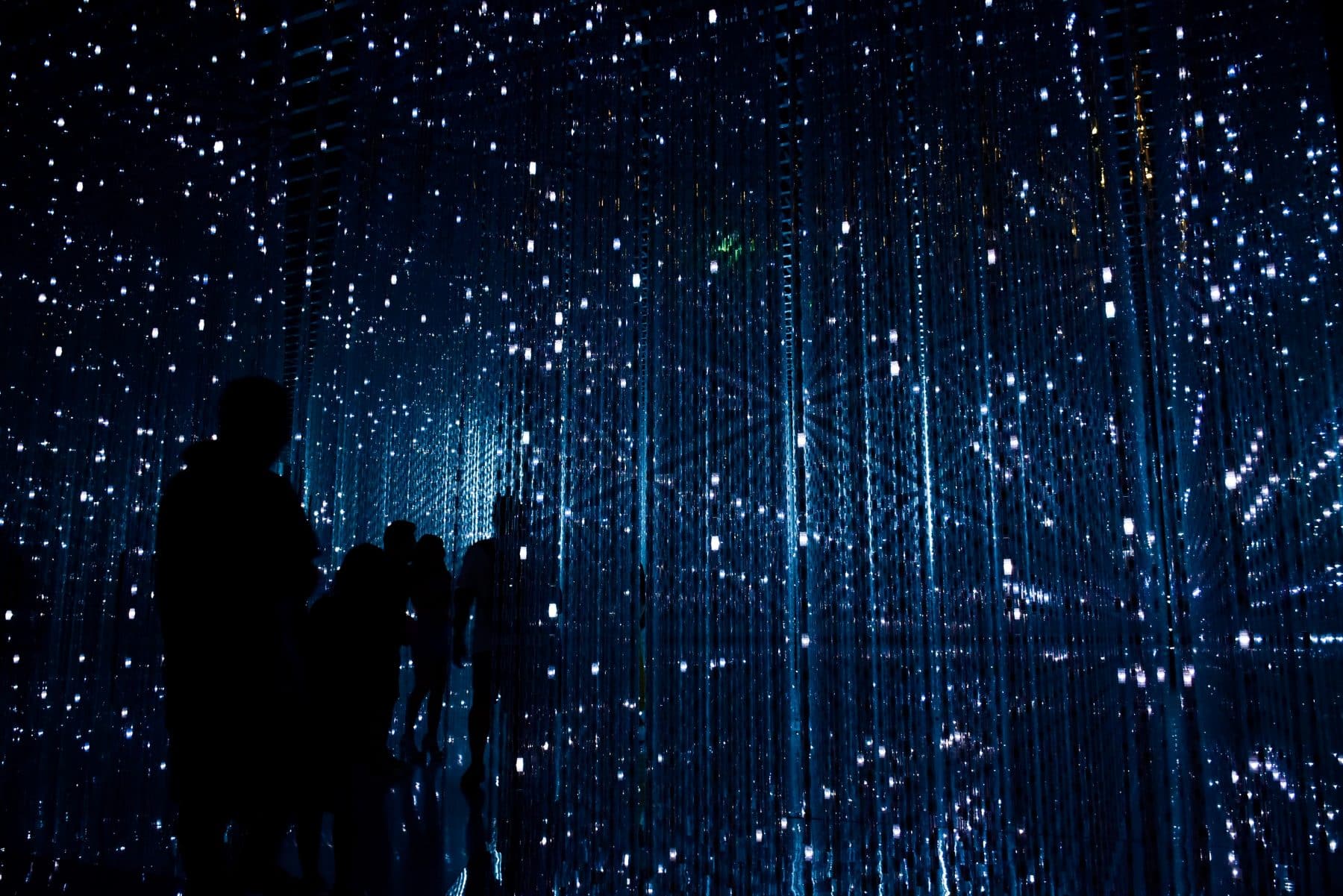1. What is the Metaverse?
While the official dictionary definition of the Metaverse is “a virtual-reality space in which users can interact with a computer-generated environment and other users,” at its simplest, the Metaverse is the mixture of the physical and digital worlds we’ve all become accustomed to living in.
The Metaverse and its current buzzword friends – NFT and Blockchain – have been a constant topic over the past few months. In all the excitement surrounding the Metaverse, the overarching narrative has built a hype machine that is focusing on the most extreme versions of the Metaverse – fully immersive worlds fueled by VR- that are still emerging and may be a few years off. These conversations make it feel that if you don’t already have an access point or plan for the Metaverse, you’re already behind (don’t worry, you’re not).
The Metaverse is not a new concept, neither in Science Fiction as coined by Neal Stephenson in Snow Crash, nor in function in the real world. The Metaverse lives on a spectrum – what I call The Spectrum of Immersion – and by talking only about its most extreme iteration we could be alienating both consumers and brands. This spectrum helps ground us in the ways in which our daily lives already interact with the Metaverse and how its fluid nature allows for flexibility in its use and utility.
2. Why Are We All Suddenly Talking About It?
On October 28th, 2021, Facebook officially changed its name and stock ticker to Meta. Why? As a signal to the future of not only where it wants to go as a company, but where Meta believes the future of the internet, in all its iterations across play, work, socialization, commerce, and beyond, will evolve and eventually reside. This announcement by Meta ties tightly to the rise of the conversations surrounding the Metaverse.
Looking at Google Trends data, it’s easy to see the correlation between the Facebook/Meta name change and the amount of time we all spend talking or listening about the Metaverse.
That big spike in the chart down below? – the timeframe when Facebook changed its name to Meta and laid out its view of what the future will look like.
And while the interest in “Meta” as a search term has had a fairly precipitous drop post-name change, Metaverse has stayed fairly flat, even bumping up at times signaling that the conversation will be here well into 2022 and beyond, especially as we continue this physical/digital pandemic way of life. Meta has merely brought to the forefront the work that has been laid by others and itself, into a mainstream narrative and audience.
3. The Metaverse is a Spectrum And You’ve Already Been There
While many of us have been speaking and hearing about the Metaverse nonstop as of late, there is data that paints a picture that the general public is not yet ready for the fully immersive worlds that many of our conversations have centered around. In fact, one third of Americans polled in a recent YouGov/The Drum survey had never even heard of the Metaverse and 72% said they aren’t likely to be using a VR headset in the next 12 months – aka the current gateway to the Meta version of Metaverse* — showcasing that our immediate jump to the extreme side of the Metaverse may be too much, too soon.
To the surprise of many, the Metaverse has already been around for over three decades. We’ve all been living in it already. We’ve been living in it since the dawn of the Internet; it’s just that our level of immersion in the digital world has been also been iterated upon. Our widespread adoption of the internet over the past 25 years has become so native and part of our daily lives across commerce, socialization, entertainment, and more, that we don’t realize or we take for granted, the evolution and merging of our physical and digital lives.
This evolution has created a (non-exhaustive) spectrum and can be plotted on The Spectrum of Immersion. If you’ve ever signed onto an AOL chatroom, you’ve been to the Metaverse. If you’ve ever used a Snapchat lens, you’ve been to the Metaverse. If you were one of the over 10 million (yes, 10 million) who logged into Fortnite during the Marshmello concert in 2019, you’ve been to the Metaverse. If you have an Oculus (now Meta) Quest, you’ve certainly been to the Metaverse. One could even argue that as I sit here “writing” on Microsoft Word I’m dipping into the Metaverse.
*https://www.thedrum.com/news/2021/11/01/facebook-beware-study-shows-most-americans-don-t-care-about-the-metaverse
The above spectrum showcases your involvement is centered on the level of immersion into the digital worlds we’ve ALREADY created. You can enter and exit the Metaverse at will by dialing up or down your immersion level, but the fact of the matter is that you’re in the Metaverse countless times a day whether you thought of it that way or not. This is where a lot of the power lies – it is flexible to meet the needs, desires, and comfort level of people who are willing to interact with it.
The Metaverse was here, is here now, and will be here to stay. But which version, or versions, of the Metaverse you participate in will vary depending on who you are. This is where flexibility and one’s comfortability comes into play. Do you want to live in a full-blown immersive world? Go for it… when that’s finally available anyway. Do you only want to put funny cat lenses on your Snapchat? I’m sure you’ll be clawing away all the attention you’ll get. Only feeling comfortable as No0BMaStEr on Xbox? That’s okay too. Do you want to live in all its iterations depending on your mood? HAVE AT IT – I know I certainly live in that fluid space.
4. The Future of the Metaverse Is Unknown, but That’s What Makes It Exciting
So what’s next for the Metaverse? It lies in The Spectrum of Immersion. The way we as people and as brands/advertisers choose to participate in the current iteration and beyond depends on how immersive you want your experiences to be (or not).
Consumers: Consumers will continue to experience the Metaverse at varying degrees of comfort, participation, and immersion depending on who they are and what they’re interested in, all while likely being completely unaware of their participation. At any given moment I can flip between listening to a podcast and asking Siri to take down a note via a serendipitous thought, dropping into Caldera (RIP Verdansk) with friends, or building an entire world in Minecraft from the ground up. The fact that consumers have already been to the Metaverse doesn’t mean that brands shouldn’t consider the existing or upcoming touchpoints. Instead it means that brands need to ensure that the experiences they are creating across the entirety of The Spectrum of Immersion are authentic for both the brand and the consumers that they are trying to reach.
Brands: Brands can capitalize in a multitude of ways as we’ve seen in the past and it ties back to The Spectrum of Immersion. Much of the current conversation around the Metaverse is focusing on the extreme interpretations of it – heavily virtual worlds. And while some brands have jumped on the most immersive version of the Metaverse, it’s imperative that we ensure its right for any of our clients their consumers and not just the latest land-grab of trends we’ve seen pop into the narrative and wash away quickly thereafter. There are five main questions that need to be asked:
1. How much education will be required for my consumer? (as noted above, not a lot of knowledge from the general population)
2. What is the level of effort & resources required? (both in hours and monetary commitment)
3. What do my brand(s) have to gain from an entrance into this space as a brand (both in social and monetary equity)?
4. Will my brand(s) presence in the Metaverse be accepted by both the community that exists there and my consumers?
5. Will my brand(s) presence in the Metaverse service existing consumers in this space or draw new consumers (both to my products but also to the Metaverse)?
Involvement can be as simple as a Facebook post or sponsored Snapchat lens by a brand, a chatbot, Star Wars making a canonical announcement tied to then upcoming The Rise of Skywalker movie within Fortnite, Disney re-creating the Magic Kingdom in Minecraft, brands and companies buying virtual real-estate, or Meta creating a virtual world where they believe we will all work, play, socialize and beyond.
We’ve seen brands like Nike, Adidas, Ralph Lauren, McDonalds, and more jump on this trend the past few months and we’re just at the acceleration point for more creativity as the technological bounds and landscape understanding expands.
5. Conclusion
Meta wants you to believe that its version of the Metaverse will be the entirety of it in the same way that Google wants you to believe that they’re the entire internet. Google isn’t the entire internet and Meta won’t be the entire Metaverse. Just like our current internet, our involvement and those that control those rails will vary.
Taking a break to pause and understand the ways in which we all interact with it already and the ways it can be varied and flexible is extremely important. We’re merely at an acceleration point. Not a creation point as many would have you think, but a broader inclusion of the general public into the idea of the Metaverse’s most immersive version. Not only is this the case because of the emerging tech that lies as a foundation of where many believe this topic will go (NFTs, Blockchain, Web3.0… that’s an entirely different POV), but instead that, for better or worse, Meta’s thrust of this topic into the public eye has brought a spotlight to an entire world that whether you know it or not has been growing for decades and you’ve already participated in.
Again, if you’re worried about being left behind, take a deep breath, and know that you’re not. You’ve already been there.
Published by PJ Evangelista




